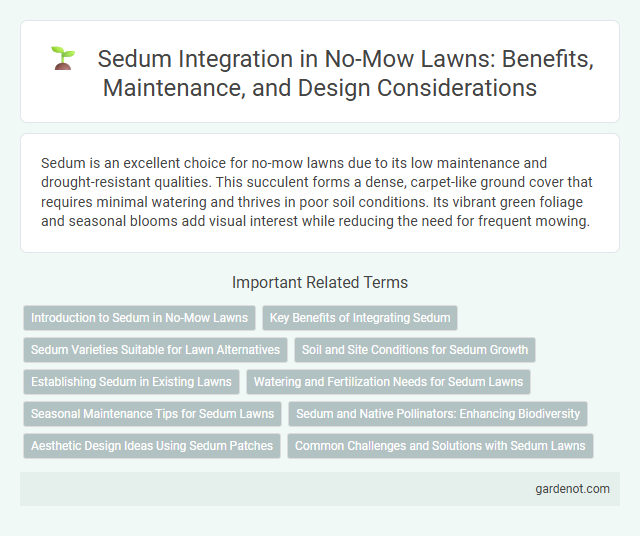Sedum is an excellent choice for no-mow lawns due to its low maintenance and drought-resistant qualities. This succulent forms a dense, carpet-like ground cover that requires minimal watering and thrives in poor soil conditions. Its vibrant green foliage and seasonal blooms add visual interest while reducing the need for frequent mowing.
Introduction to Sedum in No-Mow Lawns
Sedum is a low-maintenance succulent commonly used in no-mow lawns for its drought tolerance and minimal water requirements. Its thick, fleshy leaves store moisture, making it ideal for sustainable landscaping and reducing the need for frequent mowing or irrigation. Sedum's adaptability to various soil conditions supports healthy ground cover growth, enhancing lawn durability and aesthetic appeal with minimal upkeep.
Key Benefits of Integrating Sedum
Sedum, a drought-tolerant succulent, significantly reduces lawn maintenance by eliminating the need for mowing and frequent watering. Its ability to thrive in poor soil conditions supports sustainable landscaping and promotes biodiversity by attracting pollinators such as bees and butterflies. Integrating Sedum in no-mow lawns enhances soil retention and prevents erosion, contributing to long-term environmental benefits.
Sedum Varieties Suitable for Lawn Alternatives
Sedum varieties such as Sedum acre, Sedum spurium, and Sedum reflexum are ideal for no-mow lawn alternatives due to their drought tolerance and low maintenance requirements. These succulents form dense mats that suppress weeds, withstand foot traffic, and thrive in poor soil conditions. Their vibrant foliage and seasonal blooms provide year-round aesthetic appeal while minimizing water usage and eliminating the need for mowing.
Soil and Site Conditions for Sedum Growth
Sedum thrives in well-drained, sandy or gravelly soils with low to moderate fertility, making it ideal for no-mow lawn alternatives. It requires full sun to partial shade and performs best in sites with minimal water retention to prevent root rot. Optimal conditions include alkaline to neutral pH levels, ensuring robust growth and vibrant foliage throughout the growing season.
Establishing Sedum in Existing Lawns
Establishing Sedum in existing lawns requires selecting thin, less competitive grass areas where Sedum can root and thrive with minimal maintenance. Preparing the site by lightly removing turf and improving soil drainage encourages successful Sedum integration. Once established, Sedum significantly reduces mowing needs and improves drought resistance in no-mow lawn landscapes.
Watering and Fertilization Needs for Sedum Lawns
Sedum lawns require minimal watering, thriving best in well-drained soil with occasional irrigation only during extended dry spells. Fertilization is rarely necessary, but a light application of a balanced, slow-release fertilizer in early spring can promote healthy growth. Overwatering and excessive fertilization may lead to root rot and diminished plant vigor in Sedum lawns.
Seasonal Maintenance Tips for Sedum Lawns
Sedum lawns require minimal maintenance but benefit from seasonal care to thrive. In spring, remove debris and prune dead stems to encourage robust growth, while in summer, ensure adequate watering during prolonged droughts to prevent stress. Fall calls for light trimming and clearing fallen leaves to maintain the lawn's health and aesthetics through winter dormancy.
Sedum and Native Pollinators: Enhancing Biodiversity
Sedum species, known for their drought tolerance and low maintenance, provide essential nectar and pollen sources that support native pollinators such as bees and butterflies, enhancing local biodiversity. Incorporating sedum in no-mow lawn designs promotes a sustainable ecosystem by attracting diverse pollinator populations and improving plant-pollinator interactions. These succulent plants contribute to habitat complexity, offering shelter and foraging opportunities that increase pollinator abundance and diversity in urban and suburban landscapes.
Aesthetic Design Ideas Using Sedum Patches
Sedum patches offer vibrant textures and colors that enhance no-mow lawn aesthetics, requiring minimal maintenance while promoting eco-friendly landscaping. These drought-resistant succulents create visually appealing ground cover patterns, blending seamlessly with native grasses and wildflowers. Incorporating sedum clusters strategically around pathways and garden borders introduces dynamic contrast and year-round greenery to sustainable lawn designs.
Common Challenges and Solutions with Sedum Lawns
Sedum lawns often face challenges such as poor drainage and soil compaction, which can lead to root rot and stunted growth. Implementing well-drained soil mixtures and aerating compacted areas improve root health and promote dense, vibrant coverage. Regularly monitoring moisture levels prevents overwatering, ensuring Sedum thrives as a resilient no-mow lawn alternative.
Sedum Infographic

 gardenot.com
gardenot.com